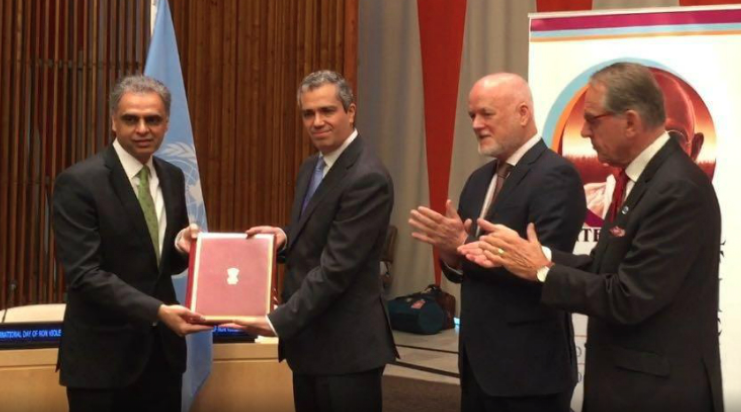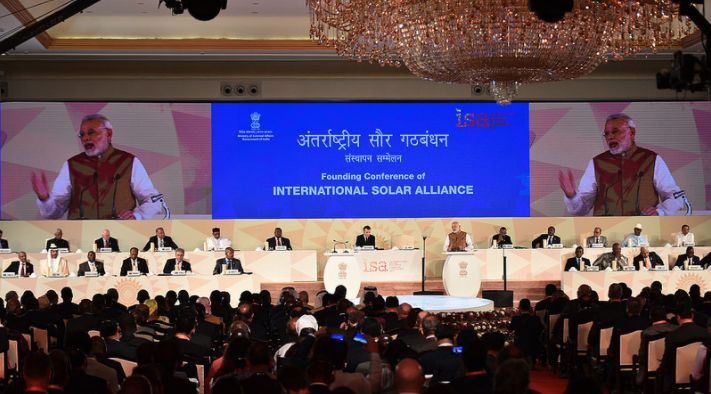- India has set for itself a target of 160 GW out of renewable energy sources by 2022. Of this, 100 GW is to be realised through solar energy.
- The quantum of the task is mammoth since as of the present only 62 GW of renewable energy capacity has been installed.
- A study by IIT-B and NISE has identified the bottlenecks that could prevent India from reaching the solar energy target.
Scientists from the Indian Institute of Technology Bombay (IIT-B) and the National Institute of Solar Energy (NISE), New Delhi, conducted a survey at 51 locations across the country and found that smaller solar photovoltaic (PV) systems degrade faster than larger installations.
The aim of the study was to assess the reliability of the existing solar PV modules, which could help India achieve the ambitious dream of 100 gigawatts (GW) of solar energy by 2022. India had committed to this target as part of its Intended Nationally Determined Contribution to the Paris Agreement of the United Nations Framework Convention on Climate Change.

Moreover, with follow-up surveys planned in 2018 and 2020, the scientists aim to generate more extensive and reliable data. Surveys with increased scope and diversity, it is believed, can help achieve the targets set in the National Solar Mission.
Juzer Vasi, Anil Kottantharayil and their IIT-B team performed multiple tests, which included current-voltage characterisation and infrared thermography. Additionally, they tested for interconnect breakage and insulation resistance. In all, they inspected 1,148 solar modules spread over 51 locations across India. The chosen locations were grouped into six climatic categories – hot and dry, warm and humid, composite, moderate, cold and sunny, and cold and cloudy.
Smaller units had more problems
Explaining what the inspection revealed, Kottantharayil told Mongabay-India, “While the large ground mounted installations had mean values of degradation rates close to what is expected, smaller installations had higher degradation rates. A large number of these panels were installed since 2010. Most of the panels installed in small installations (less than 100 kW) were found to have micro-cracks, which point to poor transportation and installation practices. Also smaller installations are unlikely to have been through a proper due diligence on quality of the panels, design and installation of the systems.”

Initial findings by the team revealed that PV modules degraded faster in hot places, on rooftops, and in installations of smaller size. Providing details on what can be done to address this issue, Kottantharayil added that the photovoltaic modules are subjected to design qualification tests specified under the International Electrotechnical Commission standard numbered IEC 61215, and similar standards. However these standards were developed assuming operating conditions similar to the moderate climatic conditions seen in Europe and the United States.
“The tests should be reviewed and appropriately adapted for hot climates. Also, due diligence on system design, quality of components, and transportation, handling and installation practices are required for ensuring enduring performance of PV systems,” he said.
Installations: Cold climate versus hot areas
“Ideally, locations with cold climate with lot of sunlight are best suited for installation of solar modules. In India, this happens only in Ladakh, where we do not have connectivity to the rest of the Indian grid nor good local connectivity,” said Vasi.
Differing, Ajith Gopi, programme officer, Agency for Non-conventional Energy and Rural Technology (ANERT), Government of Kerala, reasons, “It’s wrong to state that Ladakh is the only place in India ideal for solar installations. Though Ladakh has more cool sunny days, it has enough days with little sunshine which will affect the performance of the PV Plants in a year.”
He added: “It’s a fact that PV modules are being manufactured by rating them at Standard Test Conditions (STC) where the temperature is specified at 250 C, which is not our average ambient temperature. More research and development is required for manufacturing the PV modules friendly to hot climates. Thin film PV modules are performing better in hot climates when compared to crystalline PV modules, but still they have some limitations like efficiency.”

Reaching the 40 GW target through rooftop
In the national government’s ambitious target of generating 100 GW from solar power by 2022, 40 GW is expected to come from rooftop installations. Detailing on how this can be reached, Gopi suggests that measures such as ensuring quality PV installations in India, framing state level policies for the rooftop PV sector in consultation with the utilities and single window clearance for approval process where the State Level Nodal Agencies can take a lead. Installation standards and best practices are also important for the sustainability of the projects. Moreover, there is a need for an excellent performance monitoring system for each PV installation.
In order to promote rooftop, the government also announced the rent a rooftop solar energy policy. Gopi believes that this can be better implemented once the states takes the lead in framing guidelines since the state regulatory commissions have a better role in the state level policy for rooftop PV power plants. “The state renewable energy nodal agencies can take a lead role in framing the state level guidelines in consultation with the utility companies,” he added.
What can be done?
Some of the recommendations in the report include exercising strict due diligence while selecting and procuring modules. This may include verifying the antecedents of the manufacturer, and independent checks on the quality of the module(s). Although most modules available in the market carry the IEC certification, it is really a certification of the manufacturing process, and does not guarantee that the module will perform adequately through its intended life. This is especially important for the installation of small/medium sites, where this problem is seen to be most prevalent during this survey.
Improved training of the workforce is needed so that damages do not happen during installation of the systems. Module manufacturers and installers should place more emphasis on proper packaging and handling of the modules during transportation since improper handling can induce cracks in the solar cells and lead to long-term degradation.
Places with ‘hot’ weather present a harsh operating environment for PV modules. An intensive study of degradation phenomena in hot locations, which has not been emphasized sufficiently by the PV community so far, is needed. This is particularly important for India, since much of the 100 GW is expected to come up in such locations.
It is felt that some of the quality issues are the result of aggressive pricing and improper handling/installation, especially in the small/medium sized sites.

India has opted for an ambitious target of 160 GW of energy from renewable sources by 2022. Of this, 100 GW is expected from solar, which in turn contains a target of 40 GW from rooftop solar. To contextualise what lies ahead in the next four years, it needs to be understood that the current installed capacity of energy from renewable sources is 62 GW.
To attain the remaining part of the target there is need for a policy to encourage reliable quality installations, so that the yield is as per the projections. The IIT-B and NISE study is the first assessment of this process.